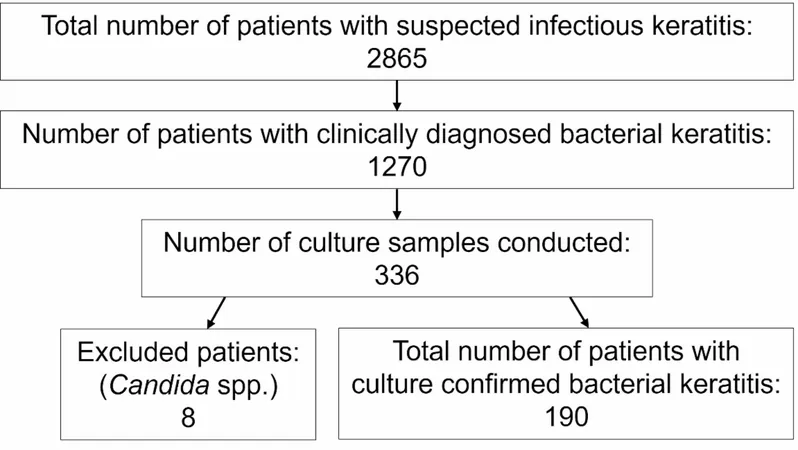
A Decade of Insights: Unveiling the Epidemic of Infectious Bacterial Keratitis in Östergötland County, Sweden
2024-10-07
Author: Daniel
Infectious keratitis (IK), a serious eye condition caused by various pathogens, remains the leading cause of corneal-related blindness globally. Among these pathogens, bacterial keratitis (BK) is the most prevalent form in colder climates, particularly in Europe and North America, whereas warmer regions like Southeast Asia see a higher incidence of fungal infections.
A significant contributor to the rise of contact lens-related keratitis can be attributed to the growing popularity of contact lenses in Europe and North America. In Sweden, a staggering 45% of patients with IK reported contact lens use before their infection—a telling statistic that emphasizes the risks associated with these commonly worn ocular devices. While this study sheds light on contact lens wear as a substantial risk factor, it leaves questions regarding the prevalence of other medical conditions, such as glaucoma, within the infected population.
Glaucoma patients face unique challenges. The treatment often involves lifelong use of eye drops, which can, paradoxically, exacerbate ocular surface disease (OSD) due to toxic components. Alarmingly, studies demonstrate that 10%-60% of glaucoma eye drop bottles may harbor bacterial contamination—sometimes even those purportedly sealed. This poses a significant risk of infections, prompting the current research to delve deeper into the intersection of glaucoma and keratitis.
In Sweden, the primary treatment for BK involves broad-spectrum topical antibiotics such as fluoroquinolones. Unfortunately, the rampant use of these antibiotics has led to increased resistance in certain regions. Thus, local epidemiological surveillance becomes critical in ensuring effective treatment protocols.
The objective of this 10-year retrospective study (2010-2019) was twofold: firstly, to identify the bacterial species responsible for BK in Östergötland County and their associated risk factors; secondly, to assess the antibiotic susceptibility of these bacteria.
The study utilized electronic health records to pinpoint patients diagnosed with keratitis and, subsequently, narrowed down the cohort through a meticulous selection process overseen by expert ophthalmologists. The research uncovered that the clinical diagnosis of BK occurred in 1,270 patients, with laboratory tests confirming 190 cases. Notably, ages ranged from infants to seniors (1-99 years), demonstrating the widespread nature of this infection. Interestingly, among these, a significant age disparity surfaced: those who wore contacts had a median age of 39 compared to 71 for non-wearers.
Morning more closely at microbiological results, it was evident that the majority of bacteria identified were coagulase-negative staphylococci (CoNS) and Staphylococcus aureus, which collectively accounted for a considerable percentage of infections. Such findings highlight the important role of personal health practices, like contact lens hygiene, and medical conditions in the evolution of BK.
The strikingly high prevalence of BK among contact lens users poses pivotal questions about public awareness regarding proper lens care. Additionally, the association between glaucoma and increased susceptibility to infections provides an opportunity for healthcare professionals to offer tailored advice to this vulnerable demographic.
Resistance patterns identified in the antibiotics tested underscore a pressing concern for global public health. With fluoroquinolone susceptibility recorded at 90%, many strains exhibited alarming levels of resistance to chloramphenicol—a traditional fallback for treating eye infections. The researchers advocate a refreshed focus on the antibiotic stewardship that has played a pivotal role in Sweden's generally low antibiotic resistance rates.
Despite these encouraging results, the study has limitations, including a lack of follow-up data on treatment outcomes, indicating a need for more extensive, multi-regional studies across Sweden. As the battle against infectious keratitis continues, understanding the interplay between environmental factors, ocular health, and antibiotic resistance will be crucial.
This decade-spanning study not only captures the dynamics of BK in Östergötland but serves as a call-to-action for enhanced monitoring and education surrounding keratitis, especially with the increasing prevalence of contact lens wear—and the implications for public health strategies extending beyond Sweden.



 Brasil (PT)
Brasil (PT)
 Canada (EN)
Canada (EN)
 Chile (ES)
Chile (ES)
 España (ES)
España (ES)
 France (FR)
France (FR)
 Hong Kong (EN)
Hong Kong (EN)
 Italia (IT)
Italia (IT)
 日本 (JA)
日本 (JA)
 Magyarország (HU)
Magyarország (HU)
 Norge (NO)
Norge (NO)
 Polska (PL)
Polska (PL)
 Schweiz (DE)
Schweiz (DE)
 Singapore (EN)
Singapore (EN)
 Sverige (SV)
Sverige (SV)
 Suomi (FI)
Suomi (FI)
 Türkiye (TR)
Türkiye (TR)